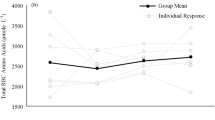Summary
We set out to demonstrate whether changes in plasma volume, haematocrit and some important blood constituents occurred after swimming 100 m and 800 m, as well as monitoring the duration of these changes.
We measured exercise-induced changes in concentration of plasma constituents in eight subjects, and determined the expected effects of haemoconcentration on these constituents. We also investigated the different biochemical responses occurring after maximal exercise (100 m), as compared to submaximal exercise (800 m).
The haematocrit increased significantly after the 100 m swim and to a lesser extent after the 800-m swim, returning to basal levels within 30 min. The plasma volume decreased by 16% on completion of the 100 m and by 8% on completion of the 800 m. The blood lactate concentration increased 15-fold and 10-fold after the 100-m and 800-m swims respectively. The plasma potassium concentration increased significantly immediately on completion of the 100-m swim, then decreased significantly at 2 1/2 and 5 min post-exercise, returning to near-basal values at 30 min. The potassium concentration measured after the 800-m event did not differ significantly from basal levels, however the measured concentrations were significantly lower than the concentrations expected on the basis of haemoconcentration. The plasma sodium concentrations measured after both 100-m and 800-m swims were significantly increased. However, calculations correcting for haemoconcentration showed significant losses in toal circulating sodium.
Our study demonstrates marked changes in plasma volume and certain blood constituents after maximal intensity swimming, and less marked changes after submaximal exercise. We also demonstrated the importance of taking the effects of haemoconcentration into account when evaluating changes in concentration of plasma constituents.
Similar content being viewed by others
References
Auvergnat R (1958) Effects immediats du travail musculaire sur le nombre des hématies, le taux de l'hémoglobine et la valeur de l'hématocrite. C Rend Soc Biol 152:176–181
Bloom SR, Johnson RH, Park DM, Rennie MJ, Sulaiman WR (1976) Differences in the metabolic and hormonal response to exercise between racing cyclists and untrained individuals. J Physiol 258:1–18
Costill DL, Saltin B (1974) Changes in the ratio of venous to body haematocrit following dehydration. J Appl Physiol 36:608–610
Critz JB (1966) Effect of swimming exercise on serum glutamic-oxalacetic transminase and hematocrit of rats. Proc Soc Exp Biol Med 121:101–104
Felig P, Johnson C, Levitt M, Cunningham J, Keefe F, Bogliol B (1982) Hypernatremia induced by maximal exercise. JAMA 248:1209–1211
Karlsson J (1971) Lactate and phosphagen concentrations in working muscle of man. Acta Physiol Scand [Suppl] 358:1–72
Laurell H, Pernow B (1966) Effect of exercise on plasma potassium in man. Acta Physiol Scand 66:241–242
Lundvall J, Mellander S, Westling H, White T (1972) Fluid transfer between blood and tissues during exercise. Acta Physiol Scand 85:258–269
Rose KD, Lowell Dunn F, Bargen D (1966) Serum electrolyte relationship to electrocardiographic change in exercising athletes. JAMA 195:155–158
Senay LC, Mitchell D, Wyndham CH (1976) Acclimatization in a hot, humid environment: body fluid adjustments. J Appl Physiol 40:786–796
Senay LC, Rogers GG, Jooste P (1980) Changes in blood plasma during progressive treadmill and cycle exercise. J Appl Physiol 49:59–65
Tibes U, Hemmer B, Schweigart U, Böning D, Fotescu D (1974) Exercise acidosis as cause of electrolyte changes in femoral venous blood of trained and untrained man. Pflügers Arch 347:145–158
van Beaumont W, Strand JC, Petrofsky JS, Hipskind SG, Greenleaf JE (1973) Changes in total plasma content of electrolytes and proteins with maximal exercise. J Appl Physiol 34:102–106
van Beaumont W, Underkofler S, van Beaumont S (1981) Erythrocyte volume, plasma volume, and acid-base changes in exercise and heat dehydration. J Appl Physiol 50:1255–1262
Wallenstein S, Zucker CL, Fleiss JL (1980) Some statistical methods useful in circulation research. Circ Res 47:1–9
Wit AG, Dalderup LM, Pol G (1962) Muscular work and potassium supply. Acta Physiol Pharmacol Neerl 11:405–410
Author information
Authors and Affiliations
Rights and permissions
About this article
Cite this article
Goodman, C., Rogers, G.G., Vermaak, H. et al. Biochemical responses during recovery from maximal and submaximal swimming exercise. Europ. J. Appl. Physiol. 54, 436–441 (1985). https://doi.org/10.1007/BF02337191
Accepted:
Issue Date:
DOI: https://doi.org/10.1007/BF02337191



